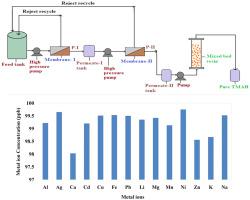Journal of Environmental Chemical Engineering ( IF 7.4 ) Pub Date : 2021-07-30 , DOI: 10.1016/j.jece.2021.106125 Bapanipally Govardhan 1, 2 , Saeed Fatima 1, 2 , Swayampakula Kalyani 1 , Sundergopal Sridhar 1, 2

|
There is a great demand for ultrapure grade tetramethyl ammonium hydroxide (TMAH) for the production of semiconductors and to remove the photoresist layer from the surface of electronic circuits. Electronic grade TMAH accounts for levels, and hence various elements present in ppb levels in technical grade TMAH are marked as impurities. In the present research work, a simplified integrated membrane-adsorption process is described to remove sub-ppm metallic impurities from technical grade TMAH. The pressure-based Nanofiltration (NF) process works effectively to hinder the diffusion of metal ion contaminants in ultrapure TMAH. It is employed in double stage mode along with resin-based post treatment for achieving desired purity levels. The hydrophilized polyamide nanofiltration (HPA-NF) membrane was synthesized in the laboratory using interfacial polymerization technique. The membrane and mixed bed resin were characterized by scanning electron microscopy (SEM) and Fourier transform infrared spectra (FTIR), atomic fluorescence spectroscopy (AFM), thermal gravimetric analysis (TGA), and differential scanning calorimetry (DSC), and energy-dispersive fluorescence spectroscopy (EDXRF) to determine the morphological, structural, thermal, and elemental analysis, respectively. A contact angle of 66.2o revealed that the prepared membrane was successfully hydrophilized. The maximum metal ion rejection was achieved to be 90 and 95% with a TMAH recovery of 80% and 85% for stage 1 and stage 2 NF treatment whereas the post treatment by resin ensured 99% metal ion rejection producing ultrapure TMAH. Cost estimation showed the hybrid process to be an economical route to purify the TMAH for semiconductor applications with feasibility for scale up.
中文翻译:

一种膜与树脂一体化处理高毒腐蚀性四甲基氢氧化铵碱至超高纯度的方法
对超纯级四甲基氢氧化铵 (TMAH) 的需求很大,用于生产半导体和去除电子电路表面的光刻胶层。电子级TMAH占水平,因此工业级TMAH中以ppb级存在的各种元素被标记为杂质。在目前的研究工作中,描述了一种简化的集成膜吸附工艺,以从工业级 TMAH 中去除亚 ppm 的金属杂质。基于压力的纳滤 (NF) 工艺可有效阻止金属离子污染物在超纯 TMAH 中的扩散。它以双阶段模式与基于树脂的后处理一起使用,以达到所需的纯度水平。在实验室中使用界面聚合技术合成了亲水化聚酰胺纳滤 (HPA-NF) 膜。膜和混床树脂通过扫描电子显微镜 (SEM) 和傅里叶变换红外光谱 (FTIR)、原子荧光光谱 (AFM)、热重分析 (TGA) 和差示扫描量热法 (DSC) 以及能量色散荧光光谱 (EDXRF) 分别确定形态、结构、热和元素分析。66.2o 的接触角表明制备的膜成功亲水化。对于第 1 阶段和第 2 阶段 NF 处理,最大金属离子截留率分别达到 90% 和 95%,TMAH 回收率为 80% 和 85%,而树脂后处理确保了 99% 的金属离子截留率,产生了超纯 TMAH。成本估算表明,混合工艺是纯化 TMAH 用于半导体应用的经济途径,具有扩大规模的可行性。











































 京公网安备 11010802027423号
京公网安备 11010802027423号